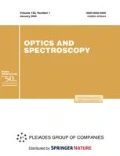Abstract
The results of a study of the optical properties of conducting polymers, namely, derivatives of poly-N-epoxypropylcarbazole (PEPC) with heavy atoms, are presented. It is shown that a heavy atom in the structure of a polymer molecule leads to bathochromic shifts in the absorption, fluorescence, and phosphorescence spectra. This is a consequence of a decrease in the energy of the electron levels due to a change in the electron density distribution over the π-electron system in the chromophores of 2IPEPC and 3BrPEPC. Two bands can be distinguished in the fluorescence spectra of PEPC with heavy atoms, just as in the parent polymer. The emission band with a maximum at 380 nm belongs to the monomer luminescent centers and the long-wavelength emission with a maximum at about 420 nm to the polymer excimers. A heavy atom changes the ratio of the intensities of the monomer and excimer bands. The fluorescence lifetimes also decrease in the presence of a heavy atom. Quantum-chemical estimation of the intramolecular transition constants has shown that the probability of the singlet–triplet intercombination conversion in the halogen-containing PEPCs is higher in PEPC. This leads to a markedly stronger phosphorescence of the iodine and bromine-containing polymers and a shorter luminescence lifetime. The obtained results can be used in the development of composite materials based on photoconductive polymers for photovoltaics and optoelectronics.







Similar content being viewed by others
REFERENCES
V. V. Arslanov, Russ. Chem. Rev. 69, 883 (2000).
I. I. Davidenko, Information Media (Kiev. Univ., Kiev, 2010) [in Russian].
W. Zhao, D. Qian, Sh. Zhang, S. Li, O. Inganäs, F. Gao, and J. Hou, Adv. Mater. 28, 4734 (2016). doi 10.1002/adma.201600281
T. N. Singh-Rachford and F. N. Castellano, Coord. Chem. Rev. 254, 2560 (2010). doi 10.1016/j.ccr.2010.01.003
M. L. Keshtov, S. A. Kuklin, A. R. Khokhlov, I. O. Konstantinov, N. V. Nekrasova, Xie Zhi-yuan, S. Biswasd, and G. D. Sharma, New J. Chem. 42, 1626 (2018). doi 10.1039/C7NJ03981F
Zh. Li, X. Xu, W. Zhang, X. Meng, Z. Genene, W. Ma, W. Mammo, A. Yartsev, M. R. Andersson, and R. A. J. Janssen, Energy Environ. Sci. 10, 2212 (2017). doi 10.1039/C7EE01858D
N. Kh. Ibrayev, D. A. Afanasyev, A. A. Ishcenko, and N. A. Davidenko, High Energy Chem. 47, 41 (2013). doi 10.1134/S0018143913020069
N. Kh. Ibrayev, D. A. Afanasyev, A. A. Ishcenko, and N. A. Davidenko, Opt. Spectrosc. 114, 66 (2013). doi 10.1134/S0030400X13010128
S. P. McGlynn, T. Azumi, and M. Kinoshita, Molecular Spectroscopy of the Triplet State (Prentice-Hall, Englewood Cliffs, NJ, 1969).
G. V. Maier, V. Ya. Artyukhov, and O. K. Bazyl’, Electron-Excited States and Photochemistry of Organic Compounds (Nauka, Novosibirsk, 1997) [in Russian].
E. V. Seliverstova and N. Kh. Ibrayev, Opt. Spectrosc. 122, 207 (2017). doi 10.1134/S0030400X17020242
S. N. Hari, Advanced Functional Molecules and Polymers: Electronic and Photonic Properties (Taylor and Francis Group, Boca Raton, FL, 2001).
Wang Zi-Han, H. Lee, and H. N. Cu, J. Appl. Phys. 111, 023512 (2012). doi 10.1063/1.3678453
A. Bruno, A. di Girolamo del Mauro, and G. Nenna, J. Photon. Energy 3, 2 (2013). doi 10.1117/1.JPE.3.033599
M. Pope and Ch. Swenberg, Electronic Processes in Organic Crystals and Polymers (Oxford Univ. Press, Oxford, 1999), Vol. 2.
Yu. A. Skryshevskii, Phys. Solid State 52, 1308 (2010).
N. N. Barashkov, T. V. Sakhno, R. N. Nurmukhametov, and O. A. Khakhel’, Russ. Chem. Rev. 62, 539 (1993). doi 10.1070/RC1993v062n06ABEH000032
J. Guillet, Polymer Photophysics and Photochemistry (Cambridge Univ. Press, Cambridge, 1985).
ACKNOWLEDGMENTS
This work was supported by the Ministry of Education and Science of the Republic of Kazakhstan within research grants AP05133724 and BR05236691. We thank N.A. Davidenko for providing the polymer samples.
Author information
Authors and Affiliations
Corresponding authors
Additional information
Translated by O. Kadkin
Rights and permissions
About this article
Cite this article
Seliverstova, E.V., Ibrayev, N.K., Nurmakhanova, A.K. et al. Spectroscopic and Quantum-Chemical Studies of Halogen-Containing Derivatives of Poly-N-Epoxypropylcarbazole. Opt. Spectrosc. 125, 499–505 (2018). https://doi.org/10.1134/S0030400X18100223
Received:
Published:
Issue Date:
DOI: https://doi.org/10.1134/S0030400X18100223



